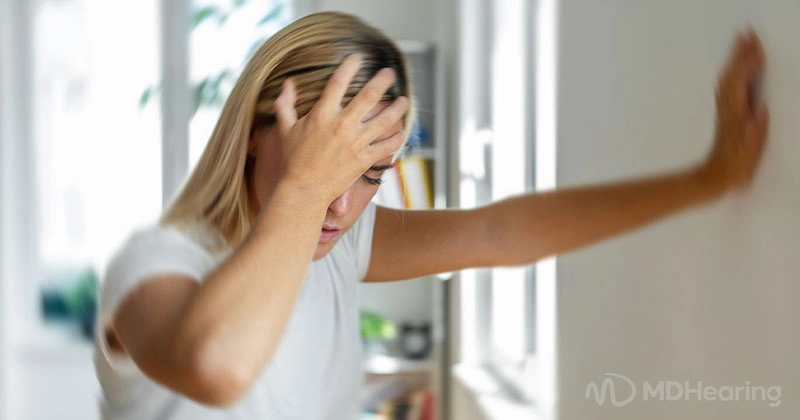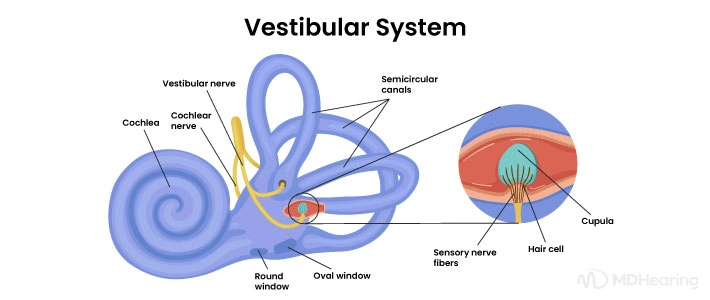Hearing is a vital body function that helps us communicate and interact with the environment. But did you know that your ears also help you to maintain your balance?
Your body is made up of interconnected systems that maintain balance. These include the visual system (eyes), vestibular system (inner ear), and proprioceptive system (sensory nerves). These work in unison to make up the balance system by collecting information from your eyes, ears, and nerves and sending it to your brain.
The balance system helps you remain positioned while sitting, standing, walking, and moving around. When you have a balance disorder, you may suffer from symptoms such as feeling dizzy or being more prone to falls.
Nearly 40% of Americans experience vertigo or dizziness at some time. One of the most common, yet often overlooked, reasons you may have balance issues is related to hearing loss. In this article, we explore the connection between hearing and balance.
What Is the Vestibular System?
Most people don't know much about the vestibular system, but it’s important to understand it as it relates to hearing health. Just like the nervous system controls sensory and motor functions in the body and the circulatory system transports oxygen, nutrients, and waste throughout the body, there’s a system devoted to balancing the body: the vestibular system.
The vestibular system is a bodily function that gives you a sense of balance and provides information about the body's position. Specifically, the system detects the position of your head in space in relation to your surroundings. In turn, your body can quickly respond to any changes in body position due to your own movement or other forces and maintain balance.
Parts of the Vestibular System
The vestibular system is situated in the inner ear and involves various structures and neural pathways. It can be broken down into two main components: the peripheral vestibular system and the central vestibular system.
Peripheral Vestibular System
The peripheral system is made up of three semicircular canals with tiny hair cells that can detect when you rotate your head. The first canal senses up-and-down movements, the second canal senses sideways movements, and the third canal senses tilting movements. In addition, sensory cells in the inner ear (known as the otolithic organs) detect when your body is being affected by acceleration and gravity.
Central Vestibular System
The central vestibular system plays an important role as part of the central nervous system. It consists of vestibular nuclei (clusters of neurons) located in the cerebellum (lower back part of the brain) and brain stem. When the peripheral vestibular system is stimulated, information is passed to the central vestibular system via the vestibular nerve. The central vestibular system processes this information, helping your body maintain proper position and balance.
Typically, you’re unaware of the function of the vestibular system. However, it’s essential to your body’s automatic reflexes for posture, balance, and coordination, as well as head and eye movements.
Relationship Between Hearing and Balance
There's a direct connection between your hearing and balance. We already mentioned that the inner ear contains the peripheral vestibular system, which functions primarily to help you maintain balance.
The inner ear also contains the cochlea, a spiral fluid-filled tube necessary for hearing. You can think of the cochlea and the peripheral vestibular system as neighbors. They’re very close to each other and share a nerve that transports information to your brain.
In addition to sensory input from the eyes and proprioception (the sense of self-movement, force, and body position), the vestibular system signals your brain if you’re moving. It also lets you know where your body is in space. For instance, your vestibular system tells you whether you are right-side up or upside down.
If any part of the vestibular system, including your inner ear, becomes damaged, it can impact your ability to maintain an ordinary sense of balance.
How Balance Is Connected to Hearing Loss
There are two main types of hearing loss: conductive and sensorineural. Damage to the inner ear typically results in sensorineural hearing loss. In contrast, issues with the outer ear can lead to conductive hearing loss. Maintaining good hearing health throughout your life is vital.
Hearing loss in adults, especially due to aging, can cause many negative effects. In addition to problems with balance, untreated hearing loss can trigger impaired memory and concentration, dementia (e.g., Alzheimer’s), depression, social isolation, loneliness, and safety issues.
While hearing loss itself doesn’t cause balance problems—both conditions are caused by the loss of inner ear hair cells—it’s not uncommon for people with a hearing deficit to fall more frequently. Your balance is heavily connected to your hearing, so your brain may not be able to sense your body’s position naturally.
In a 2012 Johns Hopkins study, researchers determined that even a mild degree of hearing loss tripled the risk of an accidental fall. Furthermore, that risk increases by 140 percent for every additional 10 decibels of hearing loss. A study from Washington University also showed that patients who wear hearing aids in both ears did better on balance tests when their hearing aids were turned on than when turned off.
If you or a loved one has been experiencing any common signs of hearing loss, don't delay getting your ears checked.
Conditions That Affect Balance
Many health issues can affect your balance, but a few are related to hearing and the inner ear. The most common include vestibular disorders.
Vestibular disorders can occur from damage to the membranes or nerves of the peripheral system or issues with the central nervous system. Problems in the inner ear often cause peripheral vestibular disorders. In contrast, central vestibular disorders tend to be related to your brain.
When you have a vestibular disorder, you may experience acute (sudden and lasting at least 24 hours) or chronic (long-term) symptoms. These include vertigo, nausea and vomiting, intolerance to head movements, unsteady walking, and unstable posture.
Positional Vertigo
Benign paroxysmal positional vertigo (BPPV) is an inner ear disorder in which tiny calcium deposits build up in any of the semicircular canals. BPPV causes you to feel like you’re falling. In addition, you may experience nausea, vomiting, sweating, and a slow heart rate. On average, symptoms can be present for two weeks, with each episode lasting less than one minute, several times a day.
Positional vertigo is the most common cause of peripheral vestibular dysfunction. This balance-related condition is frequently found in women and people over age fifty. It affects 20% of people with vertigo or dizziness that’s short-lasting and moderate to severe.
Vestibular Neuronitis
Vestibular neuronitis is the second most common cause of peripheral vestibular dysfunction. Researchers believe viral or bacterial infections cause this disorder. Inflammation of the vestibular and cochlear nerve can result in vertigo that lasts for days. Additionally, inflammation in the cochlea can lead to hearing loss.
Reports have shown that 23-100% of patients with an upper respiratory infection develop vestibular neuronitis. Although vertigo may improve within weeks or days, balance issues can persist for months. In these cases, hearing is not affected.
Ménierè Disease
Ménierè disease is another inner ear disorder. It’s a slow and progressive condition caused by a buildup of fluid in the cochlea. People with this vestibular disorder typically experience vertigo, tinnitus (ringing in the ear), and hearing loss. The symptoms can last anywhere from a few minutes to several hours. It’s unclear what causes the fluid buildup.
To address balance problems, a medical professional must diagnose and treat any underlying issues. You may have a condition that clears up through various treatment options, including medications, psychotherapy, rehabilitation, and surgery. In the case of hearing loss, hearing aids may be a practical solution. There are many types of hearing aids suited to the differing needs of individuals.
Do you have hearing loss? Once you understand your level of hearing loss, you can explore the many options and benefits of hearing aids.
Get Help for Your Hearing and Balance Issues
While many medical conditions can cause vertigo, dizziness, and related issues, there's a direct connection between hearing and balance. When certain parts of the inner ear are damaged or dysfunctional, it can lead to hearing loss and difficulty maintaining balance. If you have balance issues, it’s best to consult a doctor to determine your next steps, as treatments will vary depending on your condition.
Hearing aids are designed to assist with processing sensory sounds that you may not have heard in a while, like the sound of footsteps, pets underfoot, and slippery floors. Being able to process those sounds often helps hearing aid users keep their balance and avoid potentially dangerous falls.
If you think you have hearing loss, we can help. At MDHearing, we offer a free online hearing test that gives you results immediately. If your hearing test shows you have hearing loss, our FDA-registered medical-grade hearing aids may be the answer.
Check your hearing now with MDHearing’s free online hearing test and get your results instantly.
TAKE ONLINE HEARING TEST


